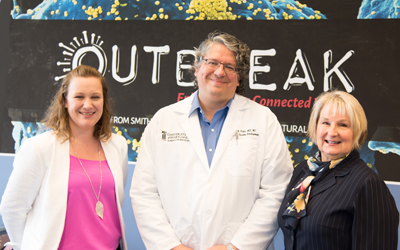“One hundred years ago, almost to the day, the Spanish Flu reached Baltimore,” said M.J. Tooey, MLS, AHIP, FMLA, associate vice president for Academic Affairs at the University of Maryland Health Sciences and Human Services Library (HS/HSL) in remarks at the library’s latest exhibit “Outbreak: Epidemics in a Connected World” on Sept. 13.

(l-r) Tara Wink, MLS, HS/HLS librarian and archivist, Justin Ortiz, MD, MS, associate professor, UMSOM, and M.J. Tooey, MLS, Vice President of Academic Affairs, HS/HLS at the opening reception for the "Outbreak: Epidemics in a Connected World" exhibit.
2018 marks the 100th anniversary of the pandemic that killed between 50 million and 100 million people worldwide. Baltimore and the University of Maryland, Baltimore (UMB) were not immune to the incredible international natural disaster.
The “Outbreak” exhibit, a collaboration with the Smithsonian Institution, also features “100 years Later: Baltimore and the Spanish Flu,” a supplemental exhibit that highlights the impact the Spanish influenza pandemic had on Baltimore, which suffered the fourth-largest death toll in the United States.
Tara Wink, MLS, HS/HSL librarian and archivist, curated the Baltimore portion of the exhibit with items loaned from the University of Maryland School of Pharmacy, the University of Maryland School of Medicine (UMSOM), and the University of Maryland School of Dentistry.
“The message behind these exhibits is ‘one health,'” said Wink. The Smithsonian exhibit and the supplemental Baltimore exhibit portray, “Just how connected human beings, animals, and the environment are.”
The Smithsonian exhibit visually presents how epidemics spread, are treated, and can be prevented in the 21st century. The Baltimore artifacts enhance the “Outbreak” message with a look at some of the recommended and the not so recommended “snake oil” treatments of the early 1900s. The gallery space also delves into how the University dealt with the epidemic.
Justin Ortiz, MD, MS, an associate professor in the Department of Medicine at UMSOM and an international flu expert, outlined the school's exciting research in the fight against influenza and worldwide pandemics. He noted researchers at the Center for Vaccine Development and Global Health are doing a great deal of work to better define the immune response for the influenza illness as well as the vaccination “so that we can produce vaccines that can protect longer than just the influenza season.”
The ultimate public health goal, he said, is to produce a universal influenza vaccine that can protect people from a number of emerging influenza viruses.
“A universal vaccine is something that is conceptually possible and I’m very pleased to be part of the University of Maryland School of Medicine because we really are at the forefront of that research,” he said.
The exhibit runs until Oct. 14 in the Weise Gallery located on the first floor of HS/HSL.
Upcoming Events:
Oct. 4 from 10 a.m. to 2 p.m. Flu Clinic – Flu shots available to all UMB faculty, staff, and students in the first-floor tower of HS/HSL. Please visit the HS/HSL website to RSVP.
Oct. 5 at 11:45 a.m. Lunch and Lecture: The 1918 Flu: What’s Past is Prologue by Philip Mackowiak, MD, SOM Class of 1970, emeritus professor of medicine and the Carolyn Frenkil and Selvin Passen History of Medicine Scholar-in-Residence. A light lunch will be served on the fifth floor of the HS/HSL in the Gladhill Board Room. RSVP to events@hshsl.umaryland.edu.


